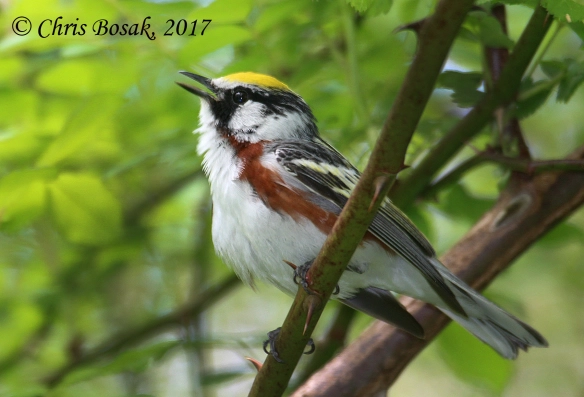
I saw a yellow-rumped warbler, a few pine warblers and several palm warblers on my last bird walk. That can only mean one thing: time for my annual spring warbler column.
The aforementioned warblers are the earliest to arrive in New England in the spring. The rest will follow shortly.
But first, what is a warbler? A warbler is a small Neotropical songbird. Many are colorful but not all of them. Yellow is a common color among warblers, but white, black, orange, brown and tan are also found frequently on warblers. While some spend their winters in the southern part of the U.S., most migrate farther to Central or South America, or the islands south of the U.S. A few stragglers may be spotted in New England during the winter, but it’s not common.
Warblers breed throughout the U.S., mostly in the northern states and into Canada. By late September and into October, warblers do their southward migration. In April and May, they pass through the area again — this time in their fresh spring plumage.
Many warblers will remain in New England to raise families, and others will head farther north. Yellow warblers and common yellowthroats, for me anyway, are the species most commonly seen during the summer raising their families. I’ve also found the breeding spots of American redstart, ovenbird, pine warbler and a few other species.
Warblers are best known in New England for their spring migration. In their best breeding plumage, dozens of species of warblers pass through New England in April and May with the peak being the first two weeks in May. This also coincides with the return of other colorful songbirds such as rose-breasted grosbeak, scarlet tanager, indigo bunting and Baltimore oriole.
Watching warblers can be incredibly rewarding and frustrating at the same time. With a few exceptions, warblers do not visit birdfeeders, meaning they must be found “in the wild.” Sometimes they are easy to find, but usually they are flitting among the leaves and hard to pinpoint. The typical size of a warbler is about five inches, so it’s not like trying to find a blue jay or robin.
Their songs are usually sung softly, so it takes a good ear to find them that way too. Also, there are dozens of warbler species and learning their songs, while infinitely valuable when in the field, is not the easiest task. Try the Merlin app to help identify warblers by song. Remember, though, while the app is extremely helpful and accurate, it is not 100 percent accurate. It’s best to “get eyes” on the birds in addition to having Merlin ID it by sound.
Some of the most common species to look for include the yellow warbler, yellow-rumped warbler, American redstart, common yellowthroat, northern parula, chestnut-sided warbler, blue-winged warbler, black-and-white warbler, black-throated green warbler, black-throated blue warbler and magnolia warbler. Ovenbirds, whose loud “teacher, teacher, teacher” song if often heard in the New England woods in the spring, are also warblers.
As I mentioned, there are dozens of other warbler species that pass through or breed in New England. A good field guide, whether an app on a smartphone or an old-fashioned paper book, is a must for identifying warblers. I wish I could describe each warbler in detail here, but obviously, that’s not feasible.
The spring warbler migration is a highlight of the year for many birdwatchers, myself included. There will be a dizzying assortment of birds to find in the coming weeks. Let me know your highlights.

happy Warbler Spring
LikeLiked by 1 person